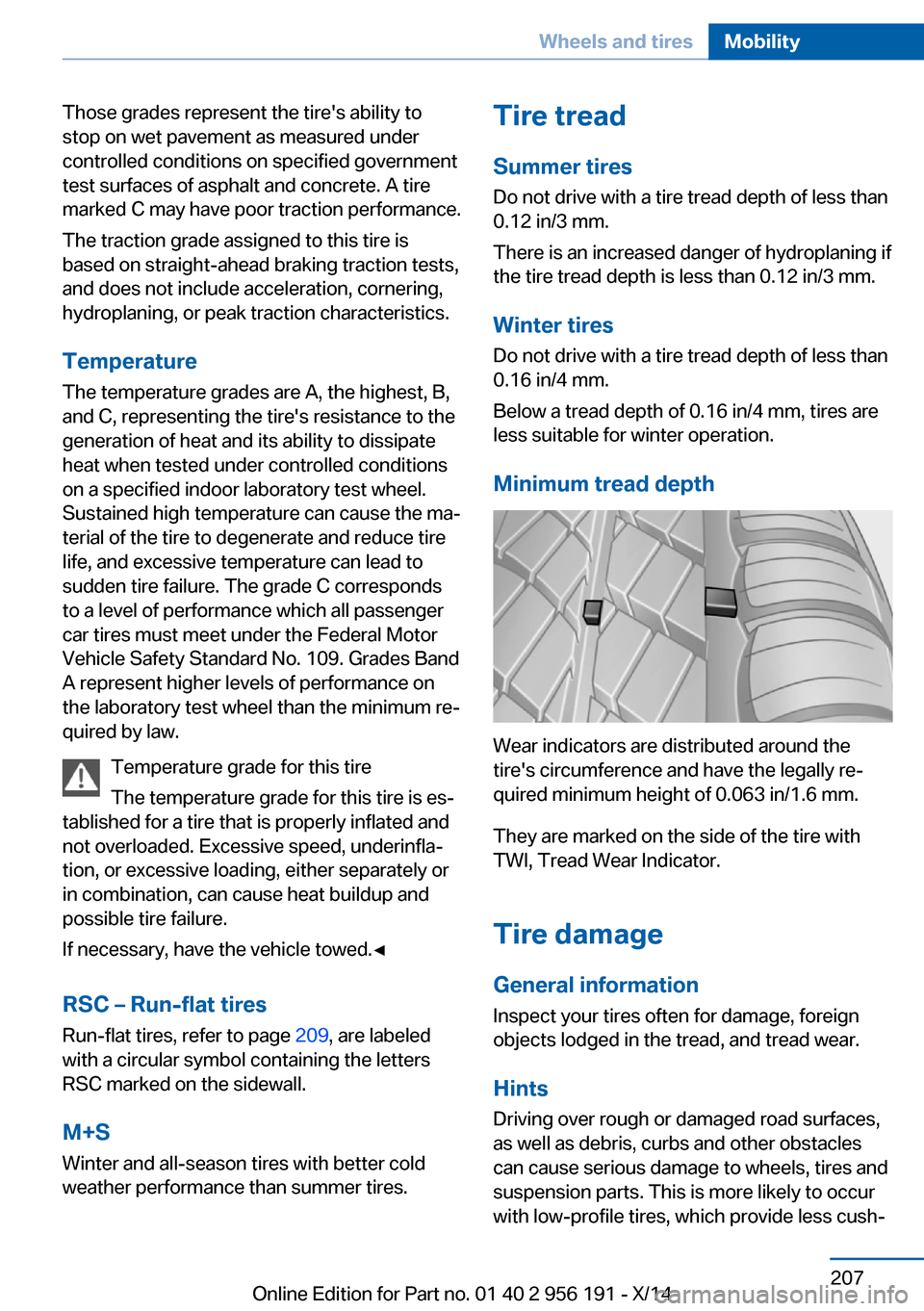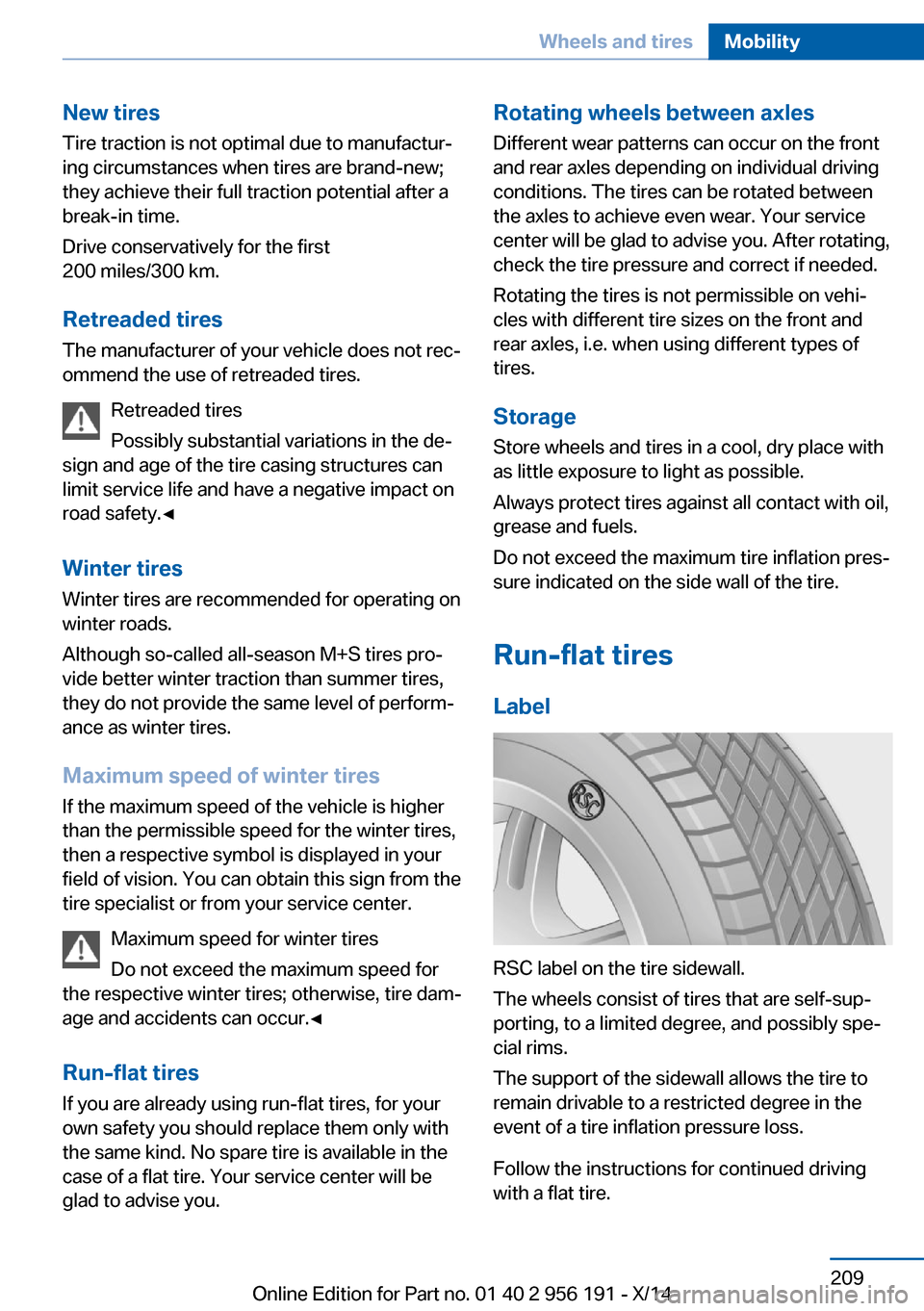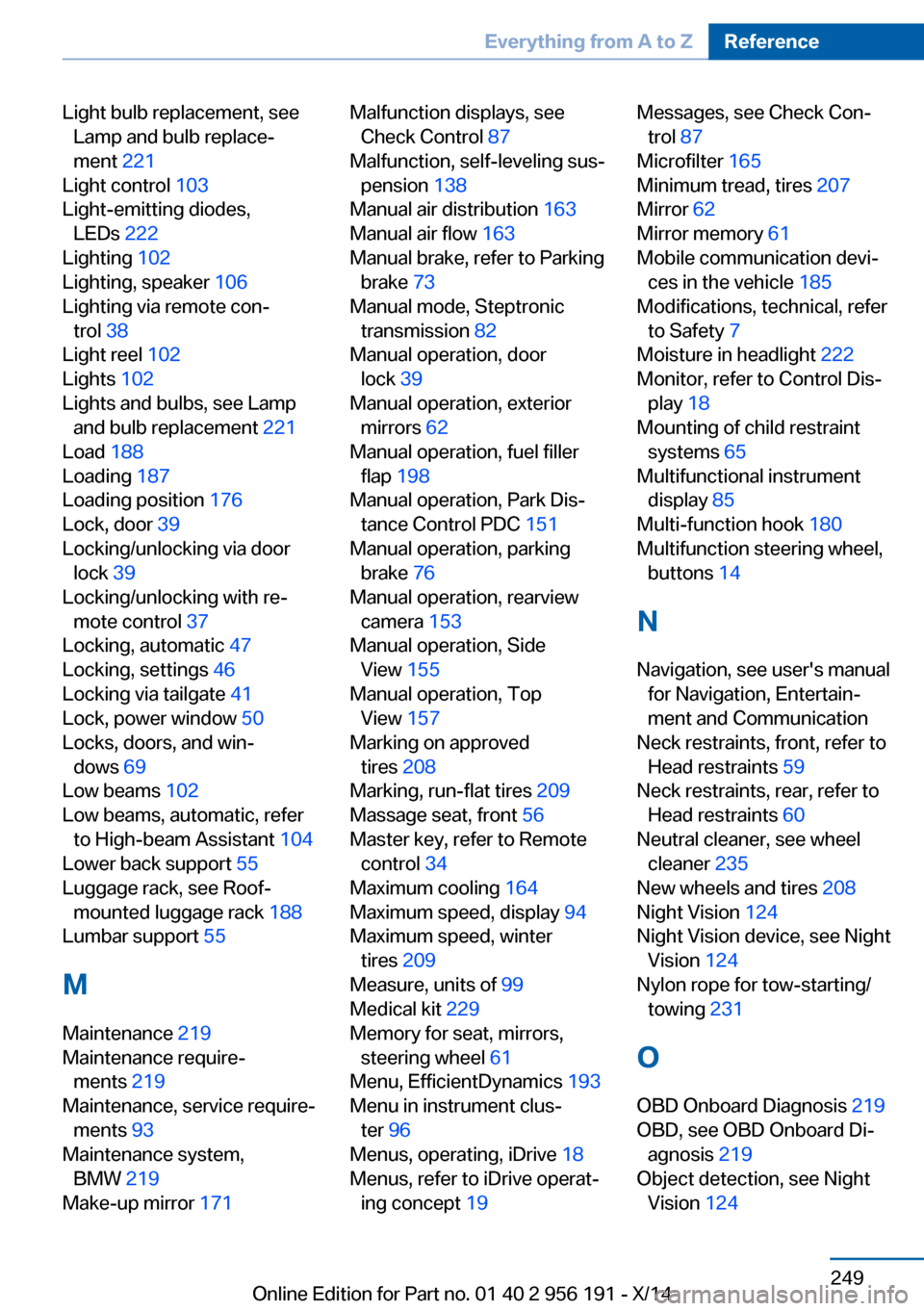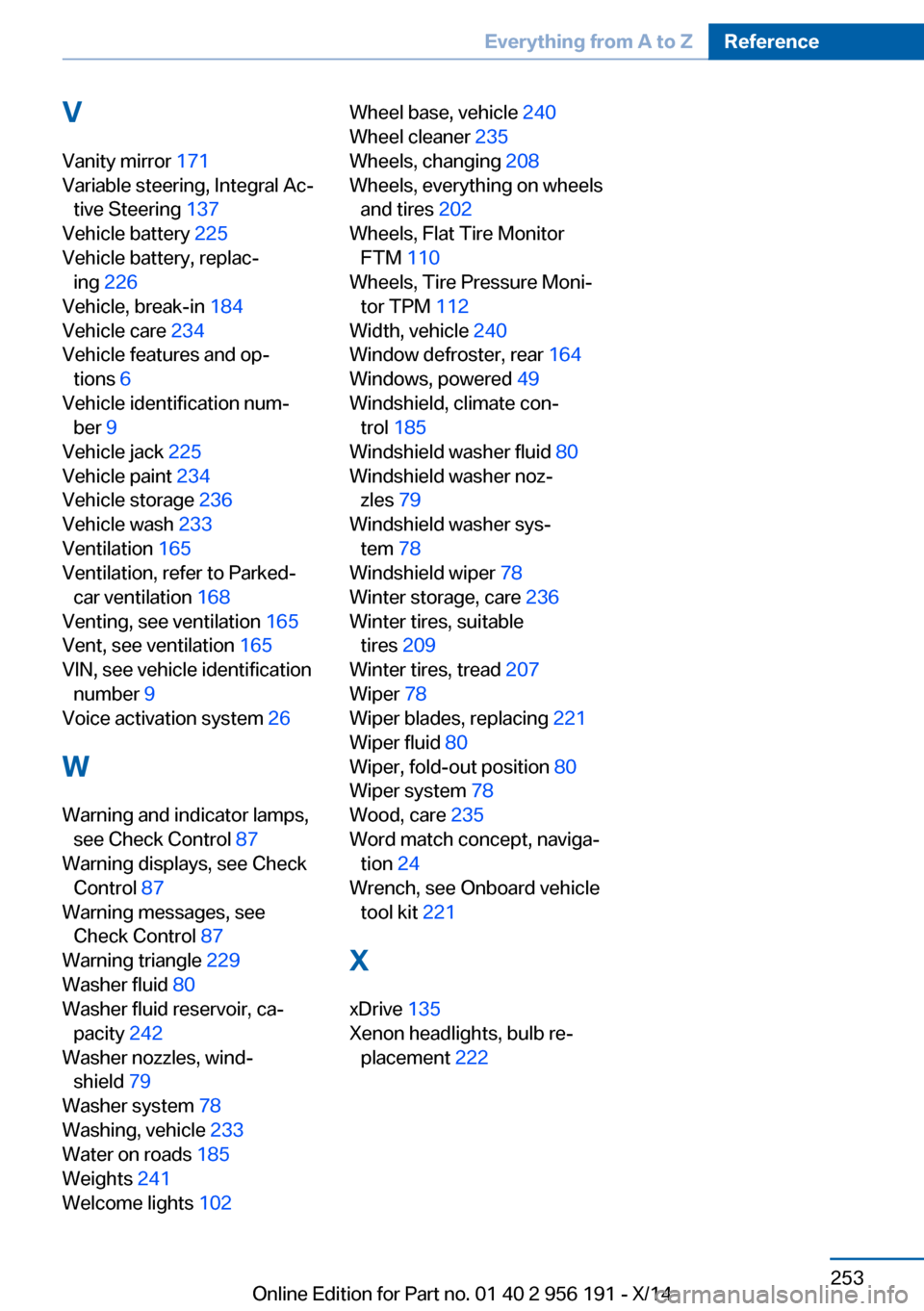2014 BMW 5 SERIES GRAN TURISMO winter tires
[x] Cancel search: winter tiresPage 211 of 259

Those grades represent the tire's ability to
stop on wet pavement as measured under
controlled conditions on specified government
test surfaces of asphalt and concrete. A tire
marked C may have poor traction performance.
The traction grade assigned to this tire is
based on straight-ahead braking traction tests,
and does not include acceleration, cornering,
hydroplaning, or peak traction characteristics.
Temperature
The temperature grades are A, the highest, B,
and C, representing the tire's resistance to the
generation of heat and its ability to dissipate
heat when tested under controlled conditions
on a specified indoor laboratory test wheel.
Sustained high temperature can cause the ma‐
terial of the tire to degenerate and reduce tire
life, and excessive temperature can lead to
sudden tire failure. The grade C corresponds
to a level of performance which all passenger
car tires must meet under the Federal Motor
Vehicle Safety Standard No. 109. Grades Band
A represent higher levels of performance on
the laboratory test wheel than the minimum re‐
quired by law.
Temperature grade for this tire
The temperature grade for this tire is es‐
tablished for a tire that is properly inflated and
not overloaded. Excessive speed, underinfla‐
tion, or excessive loading, either separately or
in combination, can cause heat buildup and
possible tire failure.
If necessary, have the vehicle towed.◀
RSC – Run-flat tires
Run-flat tires, refer to page 209, are labeled
with a circular symbol containing the letters RSC marked on the sidewall.
M+S
Winter and all-season tires with better cold
weather performance than summer tires.Tire tread
Summer tires
Do not drive with a tire tread depth of less than
0.12 in/3 mm.
There is an increased danger of hydroplaning if
the tire tread depth is less than 0.12 in/3 mm.
Winter tires
Do not drive with a tire tread depth of less than
0.16 in/4 mm.
Below a tread depth of 0.16 in/4 mm, tires are
less suitable for winter operation.
Minimum tread depth
Wear indicators are distributed around the
tire's circumference and have the legally re‐
quired minimum height of 0.063 in/1.6 mm.
They are marked on the side of the tire with
TWI, Tread Wear Indicator.
Tire damage
General information
Inspect your tires often for damage, foreign
objects lodged in the tread, and tread wear.
Hints
Driving over rough or damaged road surfaces,
as well as debris, curbs and other obstacles
can cause serious damage to wheels, tires and
suspension parts. This is more likely to occur
with low-profile tires, which provide less cush‐
Seite 207Wheels and tiresMobility207
Online Edition for Part no. 01 40 2 956 191 - X/14
Page 213 of 259

New tires
Tire traction is not optimal due to manufactur‐
ing circumstances when tires are brand-new;
they achieve their full traction potential after a
break-in time.
Drive conservatively for the first
200 miles/300 km.
Retreaded tires
The manufacturer of your vehicle does not rec‐
ommend the use of retreaded tires.
Retreaded tires
Possibly substantial variations in the de‐
sign and age of the tire casing structures can
limit service life and have a negative impact on
road safety.◀
Winter tires
Winter tires are recommended for operating on
winter roads.
Although so-called all-season M+S tires pro‐
vide better winter traction than summer tires,
they do not provide the same level of perform‐
ance as winter tires.
Maximum speed of winter tires If the maximum speed of the vehicle is higher
than the permissible speed for the winter tires,
then a respective symbol is displayed in your
field of vision. You can obtain this sign from the
tire specialist or from your service center.
Maximum speed for winter tires
Do not exceed the maximum speed for
the respective winter tires; otherwise, tire dam‐
age and accidents can occur.◀
Run-flat tires If you are already using run-flat tires, for your
own safety you should replace them only with
the same kind. No spare tire is available in the
case of a flat tire. Your service center will be
glad to advise you.Rotating wheels between axles
Different wear patterns can occur on the frontand rear axles depending on individual driving
conditions. The tires can be rotated between
the axles to achieve even wear. Your service
center will be glad to advise you. After rotating,
check the tire pressure and correct if needed.
Rotating the tires is not permissible on vehi‐
cles with different tire sizes on the front and
rear axles, i.e. when using different types of
tires.
Storage
Store wheels and tires in a cool, dry place with
as little exposure to light as possible.
Always protect tires against all contact with oil,
grease and fuels.
Do not exceed the maximum tire inflation pres‐
sure indicated on the side wall of the tire.
Run-flat tires
Label
RSC label on the tire sidewall.
The wheels consist of tires that are self-sup‐
porting, to a limited degree, and possibly spe‐
cial rims.
The support of the sidewall allows the tire to
remain drivable to a restricted degree in the
event of a tire inflation pressure loss.
Follow the instructions for continued driving
with a flat tire.
Seite 209Wheels and tiresMobility209
Online Edition for Part no. 01 40 2 956 191 - X/14
Page 237 of 259

CareVehicle features and optionsThis chapter describes all standard, country-
specific and optional features offered with the
series. It also describes features that are not
necessarily available in your car, e. g., due to
the selected options or country versions. This
also applies to safety-related functions and
systems.
Car washes
General information
Regularly remove foreign objects such as
leaves in the area below the windshield when
the hood is raised.
Wash your vehicle frequently, particularly in
winter. Intense soiling and road salt can dam‐
age the vehicle.
Hints Steam jets or high-pressure washers
When using steam jets or high-pressure
washers, hold them a sufficient distance away
and use a maximum temperature of
140 ℉/60 ℃.
If the vehicle has a glass sunroof, ensure that a
distance of at least 31.5 inches/80 cm is main‐
tained. Holding them too close or using exces‐
sively high pressures or temperatures can
cause damage or preliminary damage that may
then lead to long-term damage.
Follow the user's manual for the high-pressure
washer.◀
Cleaning sensors/cameras with high-
pressure washers
When using high-pressure washers, do not
spray the exterior sensors and cameras, e.g.,
Park Distance Control, for extended periods oftime and only from a distance of at least
12 in/30 cm.◀
Automatic car washes
Hints Do not use high pressure washing sys‐
tems
With washing systems operating at high pres‐
sures and nozzle positions close to the win‐
dows, drops of water can penetrate.◀
Note the following:▷Give preference to cloth car washes or
those that use soft brushes in order to
avoid paint damage.▷Make sure that the wheels and tires are not
damaged by the transport mechanisms.▷Fold in the exterior mirrors; otherwise, they
may be damaged, depending on the width
of the vehicle.▷Deactivate the rain sensor, refer to
page 79, to avoid unintentional wiper acti‐
vation.▷In some cases, an unintentional alarm can
be triggered by the interior motion sensor
of the alarm system. Follow the instruc‐
tions on avoiding an unintentional alarm,
refer to page 48.
Guide rails in car washes
Avoid car washes with guide rails higher
than 4 in/10 cm; otherwise, the vehicle body
could be damaged.◀
Before driving into a car wash In order to ensure that the vehicle can roll in a
car wash, take the following steps:
1.Drive into the car wash.2.Engage selector lever position N.Seite 233CareMobility233
Online Edition for Part no. 01 40 2 956 191 - X/14
Page 253 of 259

Light bulb replacement, seeLamp and bulb replace‐
ment 221
Light control 103
Light-emitting diodes, LEDs 222
Lighting 102
Lighting, speaker 106
Lighting via remote con‐ trol 38
Light reel 102
Lights 102
Lights and bulbs, see Lamp and bulb replacement 221
Load 188
Loading 187
Loading position 176
Lock, door 39
Locking/unlocking via door lock 39
Locking/unlocking with re‐ mote control 37
Locking, automatic 47
Locking, settings 46
Locking via tailgate 41
Lock, power window 50
Locks, doors, and win‐ dows 69
Low beams 102
Low beams, automatic, refer to High-beam Assistant 104
Lower back support 55
Luggage rack, see Roof- mounted luggage rack 188
Lumbar support 55
M
Maintenance 219
Maintenance require‐ ments 219
Maintenance, service require‐ ments 93
Maintenance system, BMW 219
Make-up mirror 171 Malfunction displays, see
Check Control 87
Malfunction, self-leveling sus‐ pension 138
Manual air distribution 163
Manual air flow 163
Manual brake, refer to Parking brake 73
Manual mode, Steptronic transmission 82
Manual operation, door lock 39
Manual operation, exterior mirrors 62
Manual operation, fuel filler flap 198
Manual operation, Park Dis‐ tance Control PDC 151
Manual operation, parking brake 76
Manual operation, rearview camera 153
Manual operation, Side View 155
Manual operation, Top View 157
Marking on approved tires 208
Marking, run-flat tires 209
Massage seat, front 56
Master key, refer to Remote control 34
Maximum cooling 164
Maximum speed, display 94
Maximum speed, winter tires 209
Measure, units of 99
Medical kit 229
Memory for seat, mirrors, steering wheel 61
Menu, EfficientDynamics 193
Menu in instrument clus‐ ter 96
Menus, operating, iDrive 18
Menus, refer to iDrive operat‐ ing concept 19 Messages, see Check Con‐
trol 87
Microfilter 165
Minimum tread, tires 207
Mirror 62
Mirror memory 61
Mobile communication devi‐ ces in the vehicle 185
Modifications, technical, refer to Safety 7
Moisture in headlight 222
Monitor, refer to Control Dis‐ play 18
Mounting of child restraint systems 65
Multifunctional instrument display 85
Multi-function hook 180
Multifunction steering wheel, buttons 14
N
Navigation, see user's manual for Navigation, Entertain‐
ment and Communication
Neck restraints, front, refer to Head restraints 59
Neck restraints, rear, refer to Head restraints 60
Neutral cleaner, see wheel cleaner 235
New wheels and tires 208
Night Vision 124
Night Vision device, see Night Vision 124
Nylon rope for tow-starting/ towing 231
O OBD Onboard Diagnosis 219
OBD, see OBD Onboard Di‐ agnosis 219
Object detection, see Night Vision 124 Seite 249Everything from A to ZReference249
Online Edition for Part no. 01 40 2 956 191 - X/14
Page 257 of 259

V
Vanity mirror 171
Variable steering, Integral Ac‐ tive Steering 137
Vehicle battery 225
Vehicle battery, replac‐ ing 226
Vehicle, break-in 184
Vehicle care 234
Vehicle features and op‐ tions 6
Vehicle identification num‐ ber 9
Vehicle jack 225
Vehicle paint 234
Vehicle storage 236
Vehicle wash 233
Ventilation 165
Ventilation, refer to Parked- car ventilation 168
Venting, see ventilation 165
Vent, see ventilation 165
VIN, see vehicle identification number 9
Voice activation system 26
W Warning and indicator lamps, see Check Control 87
Warning displays, see Check Control 87
Warning messages, see Check Control 87
Warning triangle 229
Washer fluid 80
Washer fluid reservoir, ca‐ pacity 242
Washer nozzles, wind‐ shield 79
Washer system 78
Washing, vehicle 233
Water on roads 185
Weights 241
Welcome lights 102 Wheel base, vehicle 240
Wheel cleaner 235
Wheels, changing 208
Wheels, everything on wheels and tires 202
Wheels, Flat Tire Monitor FTM 110
Wheels, Tire Pressure Moni‐ tor TPM 112
Width, vehicle 240
Window defroster, rear 164
Windows, powered 49
Windshield, climate con‐ trol 185
Windshield washer fluid 80
Windshield washer noz‐ zles 79
Windshield washer sys‐ tem 78
Windshield wiper 78
Winter storage, care 236
Winter tires, suitable tires 209
Winter tires, tread 207
Wiper 78
Wiper blades, replacing 221
Wiper fluid 80
Wiper, fold-out position 80
Wiper system 78
Wood, care 235
Word match concept, naviga‐ tion 24
Wrench, see Onboard vehicle tool kit 221
X
xDrive 135
Xenon headlights, bulb re‐ placement 222 Seite 253Everything from A to ZReference253
Online Edition for Part no. 01 40 2 956 191 - X/14